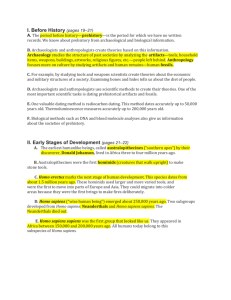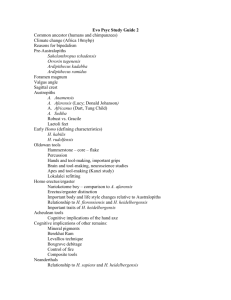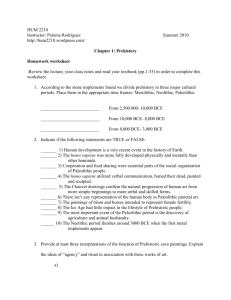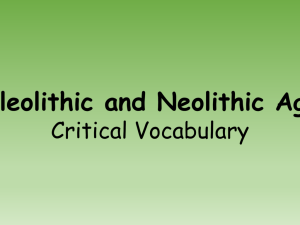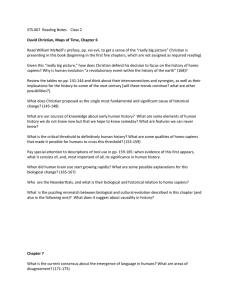Bellringer • What is culture? What is the culture
advertisement
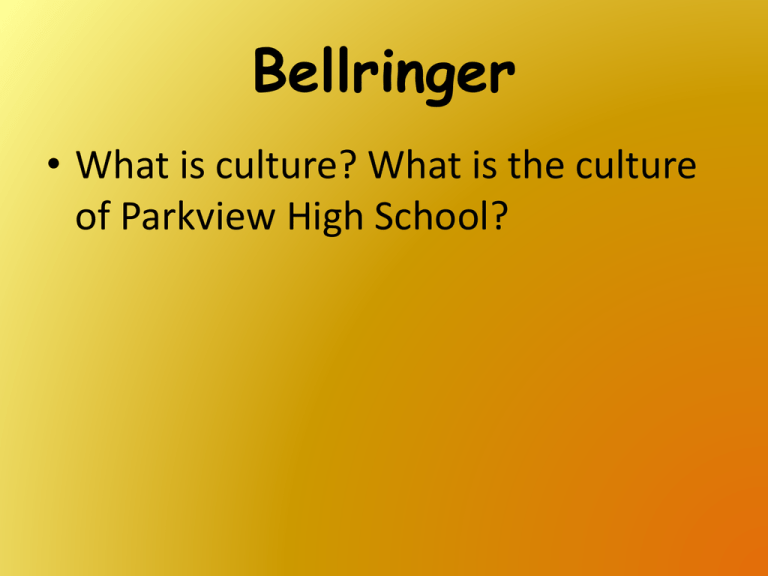
Bellringer • What is culture? What is the culture of Parkview High School? Agenda 1. 2. 3. 4. Textbook Scavenger Hunt The Paleolithic Era Hunter-gatherer life Summarizing Text Objectives Students will be able to… 1. List the major characteristics of early humans during the Paleolithic Era. 2. Evaluate the effectiveness of the hunter-gatherer lifestyle. Skills Objectives Students will be able to… S2. Take effective notes from textbook readings. S3. Interpret information presented in charts and graphs. S4. Create efficient summaries of written texts. Objective #1 Early Humans Early Humans • Start our story at the dawn of the Paleolithic Era, about 2.5 million years ago –the Old Stone Age –Humans created the first tools made out of stone Better than Monkeys • Early humans developed 1. Simple stone tools 2. Control of fire 3. Oral language • All keys to cooperating in hunts, which bring food and resources Wise Man • Smarter, larger-brained humans known as homo sapiens (Latin for “wise man”) –Developed technology • Clothing • Shelter • Art • Homo sapiens are modern humans Out of Africa • Homo sapiens arose in Africa about 200,000 years ago • Migration to all continents (except Antarctica) beginning around 100,000 years ago Out of Africa Why? Why did ancient humans leave Africa? Objective # Hunter-gatherer Life People Profiles Source of Food • Hunting –Main source, whatever they could catch, kill, and cook! • Gathering –Wild fruits, vegetables, nuts, grains, etc. • Get it? Hunter-gatherers! Size of Groups • Small groups –Clans: 60-100 people, one or a few extended families • Why? Permanent Settlements • No! They were nomads • Why move? –Follow herds –No food left –Seasons change • Too cold or hot • No water left Location Factors • Mainly, Paleolithic (and prehistoric) people followed their food –Animals migrate, so did the people • Overpopulation (of people) • Overconsumption (of resources in one spot) Getting Along • Cooperation was necessary for survival • Knew everyone in their clan – all relatives • No private property – no where to put it • No fighting other groups – no one around • Finding food…just not that hard Charts and Graphs G REEK N AME ROMAN R ESPONSIBILITIES N AME Aphrodite Ares Artemis Athena Demeter Hera Venus Mars Diana Minerva Ceres Juno Hermes Hades Poseidon Zeus goddess of beauty and love god of war goddess of hunting and childbirth goddess of war, wisdom, and crafts goddess of the harvest protector of women; wife of Zeus/Jupiter Mercury messenger of the gods Pluto god of the Underworld Neptune god of the sea Jupiter king of the gods Summarizing Text Some Terms • Summarize • Paraphrase • Plagiarize Some Tips • • • • • Use structure and organization Include major details Leave out unimportant information Show connections between ideas DON’T COPY THE TEXT!!! Some Practice • Read the excerpt from page 12 of your textbook and write a VERY short summary Bad Sample • For a long time people used to wander like nomads. Cro-Magnons hunted and gathered. Then they made technology and hunted better. Good Sample • Over time, humans became more effective at finding food. At first, nomads moved often to find more food to hunt or gather. Later, CroMagnons invented tools and then technology (like knives and needles) to improve their lives. Some More Practice • Read the article about cannibalism and write a short summary Ending Class • All the summarizing practice goes under Tools in your binder • Homework: Guided Reading notes for Chapter 1.2!
